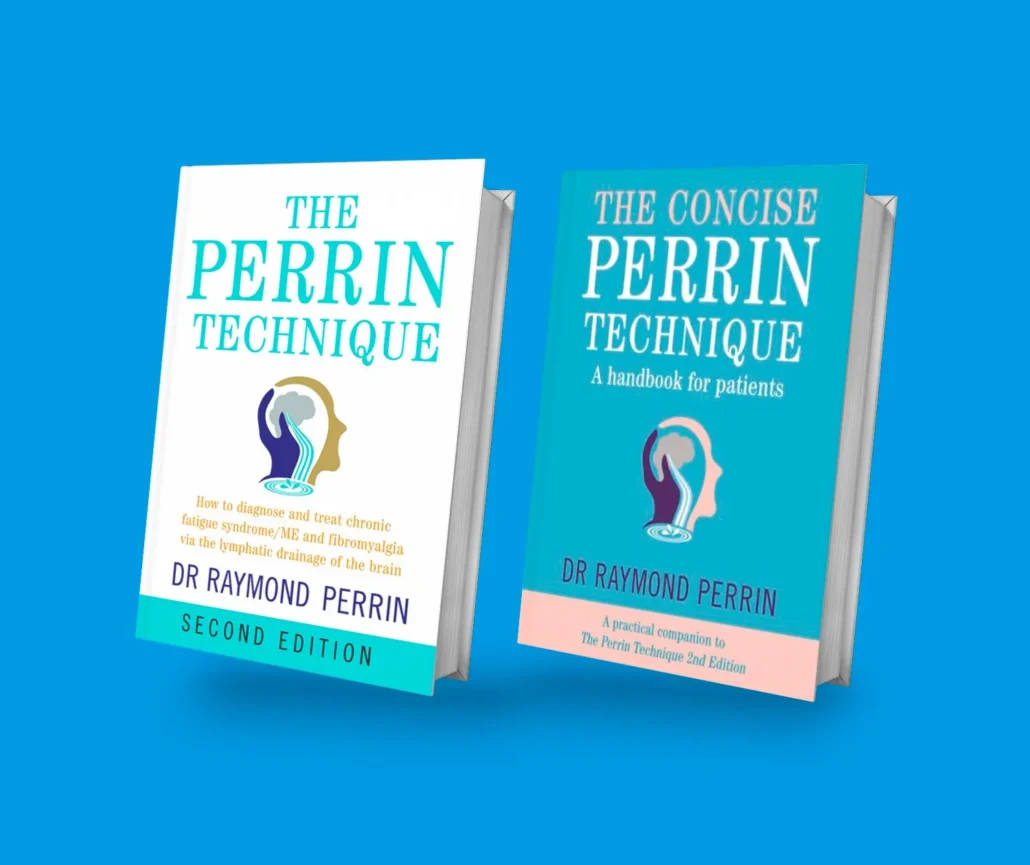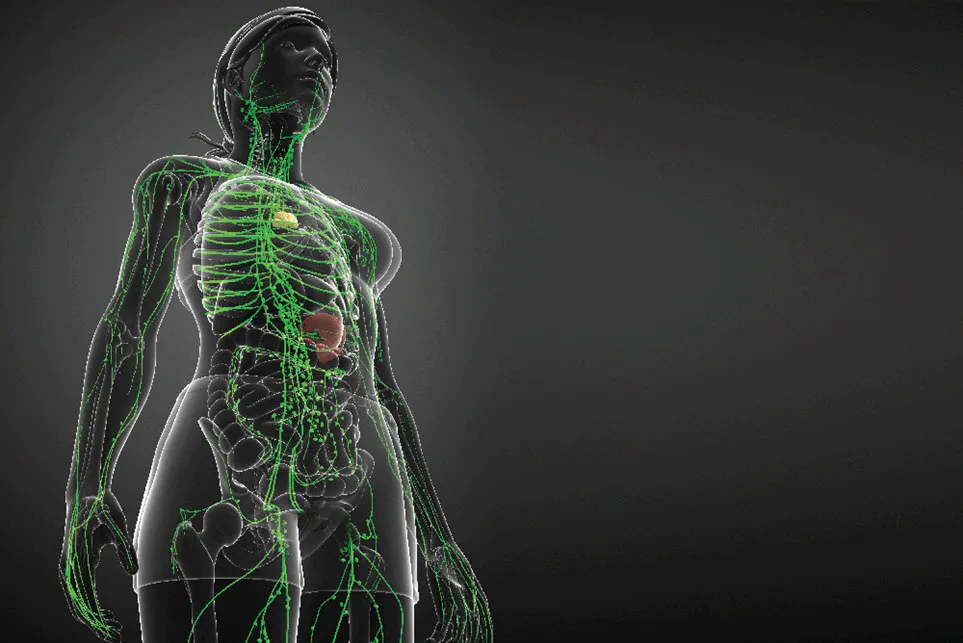Introduction
André, Raymond Perrin is known for his significant contributions to cranial and visceral osteopathy. He developed the concept of the “lymphatic pump” and explored its link with visceral health.
The concept of the “lymphatic pump” is based on the idea that specific movements in the lymphatic system, particularly in the lymph nodes and lymphatic vessels, play a crucial role in visceral health. These movements facilitate lymphatic drainage, thus contributing to the elimination of toxins and maintaining a favorable environment for the proper functioning of internal organs.

Raymond Perrin highlighted the importance of lymphatic circulation in the context of visceral disorders, suggesting that dysfunctions in the lymphatic system may contribute to various symptoms and diseases. He has developed specific techniques aimed at assessing and improving lymphatic function, providing a unique approach in treating patients.
This approach by Perrin has particularly found application in the field of chronic health, including conditions such as chronic fatigue syndrome (CFS) and fibromyalgia. By integrating the concept of the “lymphatic pump,” osteopaths trained according to this approach seek to optimize lymphatic function to promote the general health of the patient.
Lymphatic Pump Explained
The “lymphatic pump” is an osteopathic technique developed by Raymond Perrin, aimed at stimulating the movement of lymphatic fluid in the body. The lymphatic system, essential for maintaining fluid balance and eliminating waste, benefits from these specific movements.
At the heart of this concept is a targeted approach to the circulation of lymph through the lymphatic vessels. The movements applied during the “lymphatic pump” aim to promote the drainage of toxins and waste accumulated in the tissues. By improving lymphatic circulation, this technique can potentially influence visceral health by promoting better fluid balance, reducing inflammation and supporting the immune system.

Lymph, carrying nutrients and immune cells, plays a crucial role in maintaining health. The specific movements of the lymphatic pump are designed to optimize this process by encouraging the smooth movement of lymph through the lymph nodes and channels. This stimulation promotes an environment conducive to the elimination of waste, thus participating in the regulation of visceral function.
It is important to emphasize that the “lymphatic pump” is part of osteopathic approaches aimed at promoting overall health. By working on the fluidity of the body’s different systems, this technique can contribute to general balance. However, the effectiveness of the lymphatic pump can vary from person to person, highlighting the importance of consulting a qualified osteopath for personalized advice.
How is the dorsal lymphatic pump performed for pulmonary congestion?
Performing the dorsal “lymphatic pump” to relieve pulmonary congestion with the patient lying on their back is a specific osteopathic technique aimed at stimulating lymphatic circulation in the dorsal region. This approach, carried out by a qualified osteopath, is designed to promote the drainage of fluids and toxins, thereby helping to relieve pulmonary congestion.
During the session, the patient is positioned lying on his back on an examination table, creating optimal access to the dorsal region. The osteopath begins by placing his hands delicately along the spine, often at the level of the dorsal vertebrae, adopting a position that allows targeted pressure.
Dorsal lymphatic pump movements involve rhythmic, gentle pressure applied in an upward direction along the spine. These movements can take the form of gentle glides, alternating pressures or gentle stretches, aimed at stimulating lymphatic flow in the back region.
Synchronization of movements with the patient’s breathing is essential. The osteopath adjusts the pressure and rhythm of the movements according to the patient’s natural respiratory cycle, thus maximizing the effect of the technique to promote the movement of the lymph.
In addition, the osteopath can integrate light joint manipulations and gentle stretching to release possible tissue restrictions, thus improving the mobility of the structures involved in the dorsal region.
Communication between practitioner and patient remains crucial throughout the session. The patient is encouraged to provide feedback on comfort level, pressure felt, and any special sensations, allowing the osteopath to continually adjust the technique to meet specific needs.
Practical Applications in Osteopathic Treatment
The techniques developed by Raymond Perrin to assess and improve lymphatic function provide osteopaths with valuable tools to treat various disorders and support the general health of their patients. These approaches can be meaningfully integrated into an osteopath’s daily practice, contributing to a holistic approach to well-being. Among the key techniques developed by Perrin, some stand out for their applicability and effectiveness.
First of all, assessing lymphatic tension points is a crucial step. By gently palpating the lymphatic areas, particularly the cervical lymph nodes, the osteopath can identify specific points of tension. This assessment provides valuable information about the presence of lymphatic congestion, thereby guiding the practitioner in designing a treatment plan tailored to the patient’s individual needs.
The Osteopathic Lymphatic Drainage Technique (OLD), a notable creation of Perrin, can be practically integrated into each session. This technique involves gentle movements aimed at stimulating lymphatic circulation, thus promoting the drainage of toxins and waste. The osteopath can adjust the pressure and direction of movement based on the patient’s responses, ensuring a personalized approach.
The assessment of lymphatic congestion points in the skull constitutes another key dimension of Perrin’s techniques. By applying gentle pressure to certain cranial areas, the osteopath can detect signs of congestion, providing additional clues about the state of the lymphatic system. This assessment can be integrated synergistically with other techniques for a more comprehensive approach.
Osteopathic manipulations targeting the mobilization of skull membranes are also relevant for improving lymphatic function. By working on craniosacral mobility, the osteopath facilitates the movement of fluids, including lymph. These mobilizations can be adapted to the specific needs of the patient, thus complementing the overall treatment.
Finally, Perrin emphasizes the importance of promoting hydration and nutrition to support lymphatic function. Osteopaths can incorporate practical advice on their patients’ eating and drinking habits, thereby enhancing the beneficial effects of physical interventions.
- Evaluation of Lymphatic Tension Points: Perrin has developed a method for evaluating lymphatic tension points, mainly concentrated in the cervical lymph nodes. An osteopath can incorporate this assessment by gently palpating the lymphatic areas to identify specific points of tension. This assessment can provide information about lymphatic congestion and guide treatment.
- Osteopathic Lymphatic Drainage Technique (TDL): TDL, developed by Perrin, is a specific technique that involves gentle movements aimed at stimulating lymphatic circulation. It can be integrated into daily practice by adapting the manipulations according to the patient’s needs. These movements promote the drainage of toxins and waste, thus contributing to fluid balance and the regulation of the immune system.
- Evaluation of Lymphatic Congestion Points in the Skull: Perrin has also developed techniques for evaluating lymphatic congestion points in the skull. An osteopath can apply gentle pressure to certain cranial areas to detect signs of congestion. This assessment can guide the practitioner in designing a suitable treatment plan.
- Mobilization of Skull Membranes: Certain osteopathic techniques target the mobilization of the membranes of the skull, thus facilitating the movement of fluids, including lymph. These mobilizations can be integrated into the session to improve craniosacral mobility, thus promoting lymphatic circulation.
- Hydration and Nutrition Tips: In addition to physical manipulations, Perrin also emphasizes the importance of hydration and nutrition to support lymphatic function. An osteopath can provide practical advice on eating and drinking habits to adopt, thus complementing physical interventions.
The Link between Lymphatic Circulation and Visceral Disorders
Raymond Perrin has devoted a significant part of his work to exploring the link between lymphatic circulation and visceral disorders, highlighting the importance of lymphatic function in the overall health of the body. Although specific research directly linking these two aspects may be limited, the basic principles rely on an understanding of the essential roles lymphatic circulation plays in maintaining body homeostasis.
Lymphatic circulation is crucial for drainage of waste, distribution of nutrients and support of the immune system. In relation to visceral disorders, an imbalance in lymphatic circulation can have important implications. By looking at case studies or concrete examples, we can better understand this connection.
Consider a patient with chronic digestive disorders, such as irritable bowel syndrome (IBS). According to Perrin’s principles, dysfunction of lymphatic circulation could contribute to inflammation and the accumulation of toxins in the abdominal area, thus acting as a factor worsening IBS symptoms. By intervening to improve lymphatic circulation, an osteopath could potentially help reduce inflammation, promote drainage of toxins, and support visceral function.
Another situation might involve a patient with respiratory problems such as asthma. Perrin’s work highlights the crucial role of lymphatic circulation in managing inflammation. In asthma, lymphatic problems could contribute to fluid buildup and an increased inflammatory response in the airways. By integrating specific Perrin techniques aimed at improving lymphatic circulation, the osteopath could potentially support a more balanced inflammatory response and help alleviate asthma symptoms.
These concrete examples highlight the importance of lymphatic circulation in various visceral disorders. However, it is essential to note that the specific research supporting these links may vary, and the results may depend on the individual complexity of the cases.
Application of the “Lymphatic Pump” in Chronic Conditions
The application of the “Lymphatic Pump” in the treatment of chronic conditions constitutes a specific osteopathic approach aimed at favorably influencing lymphatic circulation in the body. This technique, based on the principles of gentle, rhythmic stimulation of the lymphatic system, can be significantly adapted to meet the particular needs of patients suffering from persistent conditions such as chronic fatigue syndrome (CFS) or fibromyalgia.
In the context of CFS, the Lymphatic Pump can play an essential role in managing symptoms related to persistent fatigue. By promoting lymph movement, this technique can help eliminate toxins and reduce metabolic load, potentially alleviating the fatigue associated with this condition. By stimulating the immune system, the “Lymphatic Pump” can also help strengthen the body’s resilience to the aggravating factors of CFS.
Likewise, in the case of fibromyalgia, where generalized muscle pain is predominant, the application of the “Lymphatic Pump” can aim to reduce muscle tension by promoting the drainage of interstitial fluids. By specifically targeting areas of tension, this technique can help improve mobility, relieving some of the physical burden associated with fibromyalgia.
The effectiveness of the “Lymphatic Pump” in chronic conditions relies on several mechanisms. First, gentle stimulation of lymphatic vessels promotes fluid movement, helping to reduce edema and inflammation associated with many chronic conditions. Additionally, this technique can improve local circulation, thereby promoting the delivery of oxygen and essential nutrients to affected tissues.
In the daily practice of an osteopath, the adaptation of the “Lymphatic Pump” to chronic conditions involves an individualized approach. The severity of the symptoms, the patient’s tolerance and the complexity of each case guide the practitioner in adjusting the pressure, frequency and location of the manipulations.
- Stimulation of the Immune System: In the context of CFS and fibromyalgia, where immune and inflammatory problems may be present, the “lymphatic pump” can be used to stimulate the immune system. By promoting lymphatic movement, this technique could help eliminate toxins and waste, thereby supporting immune function and potentially reducing the inflammatory burden associated with these conditions.
- Management of Inflammation: Chronic conditions are often characterized by persistent inflammation. The lymphatic pump aims to optimize lymphatic drainage, which can have an impact on the management of inflammation. By promoting the evacuation of interstitial fluids and pro-inflammatory cytokines, this technique can potentially help alleviate certain symptoms associated with chronic inflammation.
- Improved General Circulation: People with chronic conditions may experience problems with blood and lymphatic circulation. The lymphatic pump can be applied to improve general circulation, thus promoting the distribution of oxygen and essential nutrients. This approach can help support the body’s overall vitality, even in the context of chronic conditions.
- Reduced Muscle Tension: Fibromyalgia is often associated with generalized muscle tension. By integrating the “lymphatic pump”, osteopaths can aim to reduce muscle tension by promoting tissue relaxation and the release of lymph nodes. This can potentially improve the comfort and quality of life of patients with fibromyalgia.
- Stress and Nervous System Management: Chronic conditions are often linked to high levels of stress and dysregulation of the nervous system. The “lymphatic pump” can be integrated to promote relaxation and stimulate the parasympathetic nervous system. By reducing stress, this technique can help improve the immune response and alleviate some symptoms associated with CFS and fibromyalgia.
- Detoxification Support: People with chronic conditions may have difficulty removing toxins from the body. By encouraging lymphatic movement, the lymphatic pump can support natural detoxification processes. This may be particularly beneficial for patients with CFS, where toxin buildup can contribute to persistent fatigue.
- Optimization of Nutrition and Hydration: The “lymphatic pump” can be supplemented by nutritional and water advice. By improving lymphatic circulation, this technique can contribute to better absorption of nutrients and efficient distribution throughout the body. Osteopaths can advise on eating and drinking habits that promote lymphatic health.
- Progressive Approach for Fibromyalgia: In the case of fibromyalgia, where muscle sensitivity is predominant, the application of the lymphatic pump may require a gradual approach. Starting with light pressure and gradually increasing based on patient tolerance can help reduce muscle tension without triggering excessive pain.
- Patient Education and Empowerment: Lymphatic pump integration may also include educational sessions to help patients understand the importance of their own role in maintaining lymphatic health. The osteopath can teach self-help techniques, such as breathing exercises or light movements, which patients can practice at home to continually support their lymphatic circulation.
- Stimulation of Local Circulation: Chronic conditions, such as CFS and fibromyalgia, may be associated with impaired blood and lymphatic circulation to specific areas of the body. The “lymphatic pump” can be used to stimulate local circulation, thus promoting the supply of oxygen and nutrients while facilitating the evacuation of metabolic waste.
- Reduction of Tension Points and Blockages: Patients with chronic conditions often have muscle tension points and blockages that contribute to pain and stiffness. By using the lymphatic pump, osteopaths can target these specific points of tension, facilitating muscle relaxation and contributing to improved mobility.
- Improved Tissue Flexibility: Connective tissues play a crucial role in lymphatic health. The “lymphatic pump” can be applied to improve the flexibility of the tissues, thus promoting the fluid movement of the lymph. This can help reduce the feeling of stiffness associated with conditions such as fibromyalgia.
- Immune Balance Support: Immune dysfunctions are often seen in chronic conditions. The lymphatic pump can help balance the immune response by promoting the elimination of cellular debris and supporting intercellular communication. This approach may help modulate immune activity in the context of conditions like CFS.
- Management of Edema and Inflammation: Chronic conditions can lead to problems with edema and inflammation. The lymphatic pump can be used to help manage these symptoms by stimulating lymphatic drainage. This can help reduce fluid retention and alleviate associated inflammatory processes.
Evolution of Osteopathic Thought
The innovative work of Raymond Perrin has considerably influenced the evolution of osteopathic thought, marking a significant advance in the field of visceral health. His visionary approach has broadened the horizons of the profession, making valuable contributions that have changed the way osteopaths understand and approach visceral disorders.
One of Perrin’s major contributions was his emphasis on the crucial importance of lymphatic circulation in visceral health. While traditional osteopathic thinking tended to focus primarily on blood circulation, Perrin broke new ground by emphasizing the fundamental role of the lymphatic system in regulating visceral functions. This broader perspective has transformed the understanding of osteopaths, prompting them to consider lymphatic circulation as a central element in the balance and functioning of internal organs.
Perrin also influenced osteopathic thinking by emphasizing the intimate connection between the visceral system and the lymphatic system. By demonstrating how visceral dysfunctions can influence lymphatic circulation and vice versa, he introduced a systemic and interconnected view of the body. This holistic approach has enriched osteopathic thinking by encouraging practitioners to assess the complex interactions between different physiological systems, thereby providing a more complete understanding of visceral disorders.
The specific techniques developed by Perrin, such as the “Lymphatic Pump,” also played a key role in the evolution of osteopathic thought. These precise approaches have offered osteopaths targeted tools to influence lymphatic circulation and effectively treat visceral conditions linked to lymphatic drainage problems. This individualization of techniques marked a significant change in osteopathic practice, allowing for a more personalized approach based on the unique needs of each patient.
By expanding osteopathic thinking, Perrin’s work also stimulated increased interest in neuro-immune-endocrine health. By highlighting the complex interactions between the nervous system, the immune system, and the endocrine system in the context of visceral conditions, it has promoted a deeper understanding of the mechanisms underlying chronic disorders.
- Integration of Lymphatic Circulation: Raymond Perrin has deeply integrated lymphatic circulation into his practice and understanding of osteopathy. While traditional osteopathic thinking placed more emphasis on blood circulation, Perrin emphasized the crucial importance of lymphatic drainage in maintaining homeostasis. This expanded perspective has led to a more complete appreciation of the mechanisms underlying visceral imbalances.
- Relationship Between Visceral and Lymphatic System: Perrin’s work highlighted the close relationship between the visceral and lymphatic system. By demonstrating how visceral disorders can influence lymphatic circulation and vice versa, he expanded osteopathic thinking to encompass a systemic, interconnected view of the body. This holistic approach has encouraged osteopaths to consider the complex relationships between different systems in their assessment and treatment.
- Focus on Neuro-Immuno-Endocrine Health: Perrin’s osteopathic thinking also extended to neuro-immune-endocrine health by highlighting the interactions between the nervous system, the immune system, and the endocrine system in the context visceral conditions. This expanded perspective has opened the way to a more in-depth understanding of the reciprocal influences between these systems, thereby providing new possibilities for osteopathic treatment.
- Development of Specific Techniques: Raymond Perrin developed specific techniques, such as the “Lymphatic Pump,” which enriched the arsenal of osteopathic tools. These targeted techniques aim to influence lymphatic circulation in a precise manner, thus offering specific approaches to treat visceral disorders linked to lymphatic drainage problems.
- Strengthening the Role of the Osteopath: Perrin’s work strengthened the role of the osteopath as a health professional capable of making significant contributions to the understanding and treatment of visceral conditions. His innovative approach has encouraged osteopaths to expand their skills, explore new areas of research, and play an active role in the continued evolution of osteopathic thought.
- Integration of the Concept of Lymphatic Drainage: Perrin significantly introduced the concept of lymphatic drainage into osteopathic thought. While blood circulation was traditionally the focus of osteopathic concerns, Perrin broadened this perspective by emphasizing the importance of lymphatic movement in maintaining visceral health. This development has led to a more complete understanding of the interactions between circulatory systems and their impact on visceral dynamics.
- Systemic and Interconnected Approach: Perrin’s work promoted a more systemic and interconnected osteopathic view of the body. By highlighting the connections between the lymphatic circulation, the visceral system, and other physiological systems, he encouraged osteopaths to take a holistic approach in the evaluation and treatment of patients. This integrated perspective has enriched osteopathic practice by considering the body as a dynamic and interdependent whole.
- Expanding Neuro-Immuno-Endocrine Horizons: Perrin’s work expanded osteopathic thinking to encompass neuro-immuno-endocrine influences in the context of visceral conditions. He highlighted the importance of complex interactions between the nervous system, the immune system, and the endocrine system in the regulation of visceral health. This expanded approach has allowed a deeper understanding of the mechanisms underlying chronic disorders.
- Precise and Targeted Techniques: Perrin introduced specific techniques, such as the “Lymphatic Pump,” providing osteopaths with precise tools to influence lymphatic circulation and treat visceral conditions. These targeted techniques have allowed practitioners to take a more personalized approach, tailoring their interventions based on individual patient needs.
- Promotion of Patient Autonomy: With an emphasis on lymphatic circulation, Perrin also encouraged the promotion of patient autonomy. By providing advice on the importance of maintaining healthy lymphatic circulation through hydration, exercise, and other lifestyle habits, he educated patients on their active role in maintaining their health visceral.
- Shift to a Functional Approach: Perrin’s work catalyzed a shift towards a more functionally focused osteopathic approach. By focusing on lymphatic circulation and its role in regulating visceral functions, he encouraged osteopaths to evaluate not only the anatomical structure, but also the functional dynamics of organs. This functional approach offers a more nuanced understanding of the mechanisms underlying visceral disorders.
- Broadening the Diagnostic Palette: Perrin’s osteopathic thinking broadened the diagnostic palette of osteopaths, encouraging the inclusion of lymphatic circulation in the assessment of patients. This expansion allows for more precise identification of visceral and lymphatic dysfunctions, contributing to more targeted and personalized treatment plans.
- Strengthening the Preventive Approach: By highlighting the importance of lymphatic drainage for visceral health, Perrin has strengthened the preventive approach in osteopathy. Osteopaths, inspired by his work, have become more willing to incorporate lymphatic stimulation techniques into wellness programs, helping to prevent certain visceral disorders before they become chronic.
- Exploration of New Biomechanical Connections: Perrin’s work paved the way for the exploration of new biomechanical connections between the lymphatic system and other anatomical structures. This has expanded the understanding of complex interactions within the body, suggesting links between lymphatic circulation, fascial structures, and other systems that may influence visceral health.
- Integration of Complementary Approaches: Perrin’s influence also favored the integration of complementary approaches into osteopathic practice. Osteopaths have been encouraged to collaborate with other health professionals, such as nutritionists and immune system specialists, to holistically address visceral conditions through different therapeutic modalities.
Interview with Patients Benefiting from his Techniques
Interview with Patients Benefiting from Perrin Techniques (The following is a simulation; characters are fictional and provided solely for educational purposes) :
Interviewer: We are here today with two patients who have experienced Raymond Perrin’s innovative techniques for the treatment of visceral disorders. Can you share your experience and the benefits you experienced from these approaches?
Patient 1: Absolutely. I suffered from persistent fatigue and chronic headaches for years without finding an effective solution. After consulting an osteopath trained in Perrin techniques, I began to feel significant changes. The gentle manipulations targeting lymphatic circulation brought me noticeable relief, reducing my headaches and improving my energy levels.
Interviewer: That’s encouraging to hear. And you, patient 2, can you share your experience?
Patient 2: Certainly. I was diagnosed with a complex visceral condition that was affecting my daily quality of life. After discovering Perrin’s techniques, I decided to integrate them into my treatment. The precise and adapted manipulations considerably reduced my abdominal pain and improved my mobility. It was a different approach than I had tried before, and the results were remarkable.
Interviewer: Thank you for these testimonies. Can you elaborate on how Perrin’s techniques differ from other approaches you’ve tried?
Patient 1: What really struck me was the focus on lymphatic circulation. No other healthcare professional had explained to me how crucial a role this could play in my symptoms. The specific techniques were adapted to my needs, which made all the difference.
Patient 2: Absolutely. The other approaches seemed more generic, while Perrin’s techniques were really targeted to the specific dysfunctions I was experiencing. This made me feel like the treatment was truly personalized, taking into account my particular condition.
Interviewer: How have these techniques influenced your daily life beyond reducing symptoms?
Patient 1: Beyond the reduction in fatigue and headaches, I felt more emotionally balanced. There was a sort of liberation, as if the improved lymphatic flow was having a positive impact on my overall well-being.
Patient 2: Exactly. My quality of life has improved significantly. I was able to resume some activities that I previously couldn’t do due to pain. This has had a positive domino effect on my social and emotional life.
Interviewer: Thank you both for sharing your experiences. These testimonies highlight the tangible impact of Perrin’s techniques in the daily lives of patients, offering new insight into the effectiveness of these approaches in the treatment of visceral disorders.


























